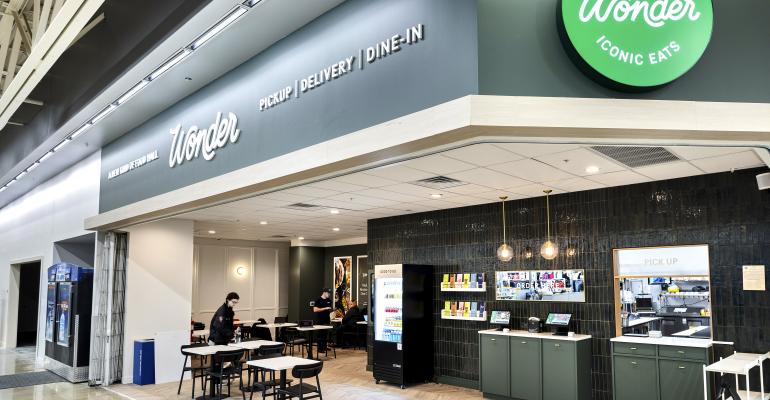Marc Lore, the billionaire ex-Walmart executive and serial entrepreneur who founded startups like Diaper.com and Jet.com, shifted his attention to the restaurant space in 2018 with the creation of Wonder. Initially, the concept featured a fleet of trucks that delivered made-to-order meals directly to customers’ homes.
About a year ago, the company shifted its model by moving to a brick-and-mortar format. It maintained its delivery-heavy focus, as well as its “fast fine” cuisine largely created by well-known chefs like Bobby Flay and Nancy Silverton. There are also proprietary brands developed by Wonder’s own chefs, such as Limesalt, Fred’s Meat & Bread, and Room for Dessert.
Up until last month, the company operated 10 locations in New York City and New Jersey. In February, it opened number 11 inside of a Walmart in Quakertown, Penn., as part of a pilot program aimed at ensuring the concept can translate essentially anywhere. The 750-square-foot Walmart space features eight different cuisines, or less than one-third of a typical New York City location.
There’s a reason Wonder is testing new locations; the company has ambitious plans to grow from 11 currently to 35 by the end of this year. As it grows, the concept has garnered the attention of several investors, pulling in about $1 billion in funding since its founding, as well as talent – last spring Wonder poached Sweetgreen CMO Daniel Shlossman to be its chief growth and marketing officer. Shlossman liked the idea of getting back into the “early days” of a company after helping to see Sweetgreen through its IPO and 200-plus units.
“When I joined (Wonder), it was just two weeks into the first brick and mortar location, and I remember going into the kitchen and seeing it and it all clicking for me,” Shlossman said during a recent interview. “If you can bring 30 or so restaurants under a single location within 3,000 square feet and you can do it with a high quality because you control every step of the way at those tight delivery radiuses, you can have an incredible product with a positive experience for the consumer.”
It is this control and these tight delivery radiuses he believes differentiates Wonder from other food hall-type concepts, some of which have experienced challenges of late. Kitchen United closed all of its locations operating inside of a Kroger late last year, for instance. So did ClusterTruck.
“The big difference is there’s vertical integration here. We own every step of this, including – and I think this is the most important piece – the brands. These are all owned by Wonder. It’s very different than bringing in a bunch of disparate companies and trying to make a virtual food hall work. Because of that, and the vertical integration gives us more control, it leads to what we believe is a better customer experience. If the customer experience is great, it will work,” Shlossman said.
There’s also the food. All of Wonder’s dishes are approved by the chefs; so, Bobby Flay has to approve the steaks, for example, while Marcus Samuelson approves Streetbird’s fried chicken sandwich. Shlossman said Wonder meets with the chefs and their teams to develop the menu within its model. Wonder then runs a single location test for four to nine weeks.
“Only when we see customer scores that are at a level we’re comfortable with, it can go to all locations basically overnight because of how we structure deals,” he said. That structure is an equity partnership versus royalties. “This isn’t about selling one extra fried chicken sandwich; this is about building the value of Wonder. That’s how the deal ultimately works out and is a win/win on both sides.”
The path ahead
It’s clear Shlossman believes Wonder is disrupting the industry based on its model and its chef roster. It’s the company’s Net Promoter Score that is giving him the most confidence, however. He notes that Wonder’s NPS score is about 60-plus, while most food delivery scores are “in the single digits.”
“The numbers we’re seeing from a revenue and customer repeats, their intent to return – all the things that matter – everything is incredible,” Shlossman said. “When you have this curated selection and then you build everything to delivery or pick up really well and you’re thinking of that consumer use case – it’s something that’s clearly resonated.”
As Wonder continues to grow, it will maintain its “tight delivery radiuses” to differentiate; about six minutes in urban locations and about 10 minutes in suburban. It will also continue to test Walmart locations, with two more opening in May. The first so far has “blown away our expectations with our second highest customer ratings of any launch thus far,” Shlossman said.
“We’re trying to figure out how this is going to work in a different environment. We’re really proud of how the model has adapted so quickly to so many different consumer types,” he adds.
Notably, Wonder is demonstrating enough throughput in its existing locations to be on its third kitchen iteration in just a year, adding things like conveyor belts and other automated equipment to keep up with demand. The company will continue to iterate and test as it continues to grow.
“Wonder was built to work anywhere and everywhere, and we’ve proven we’re able to move at a fast speed in a restaurant world that maybe doesn’t always move at that speed,” Shlossman said.
With its current tailwind, Wonder is hyper focused on densifying the Northeast in the near term. After that, only time will tell.
“Do we see runway in the middle of the country or along the West Coast? Absolutely,” Shlossman said. “We are proving this is a concept that fits anywhere.”
Contact Alicia Kelso at [email protected]





